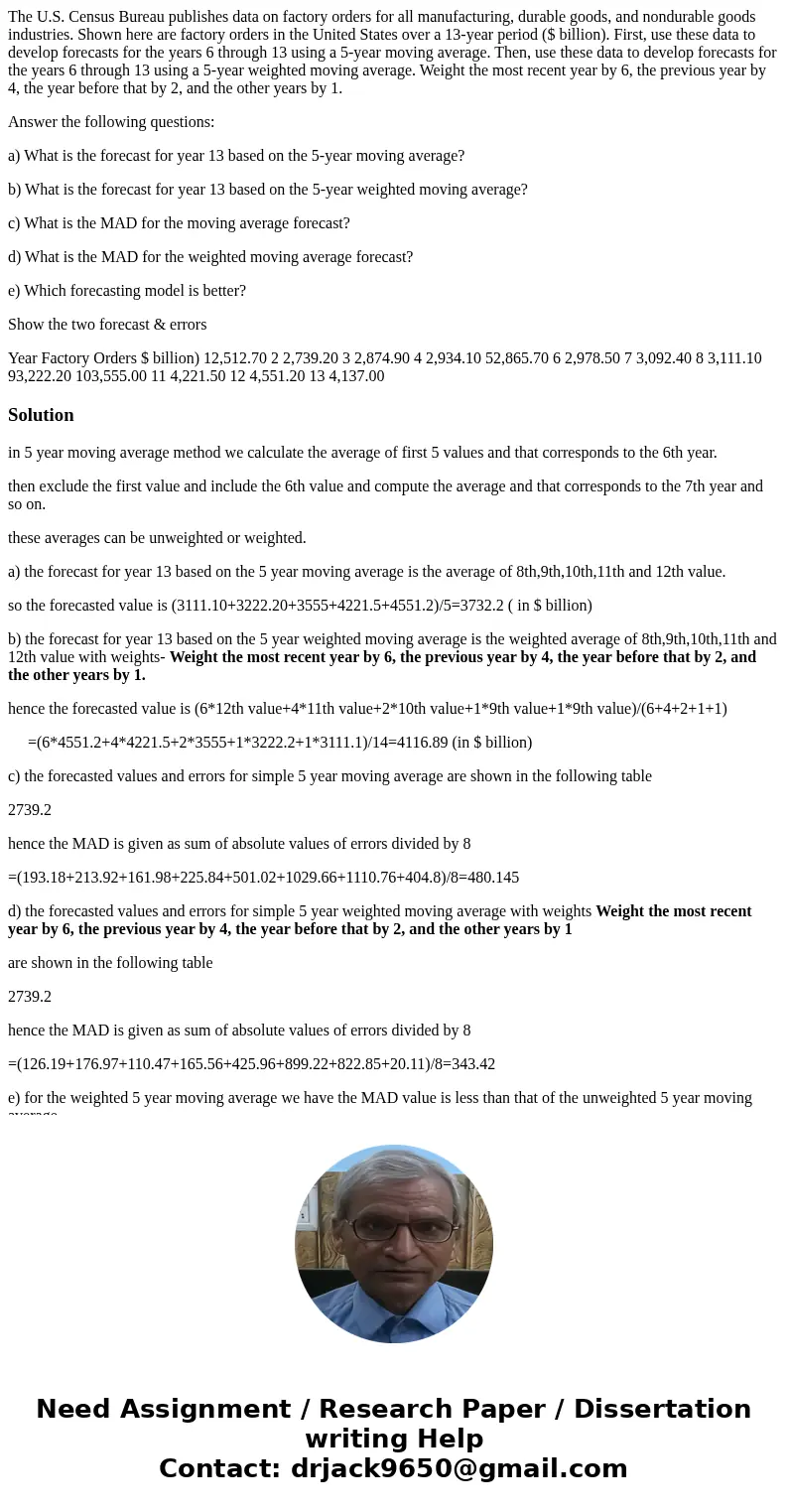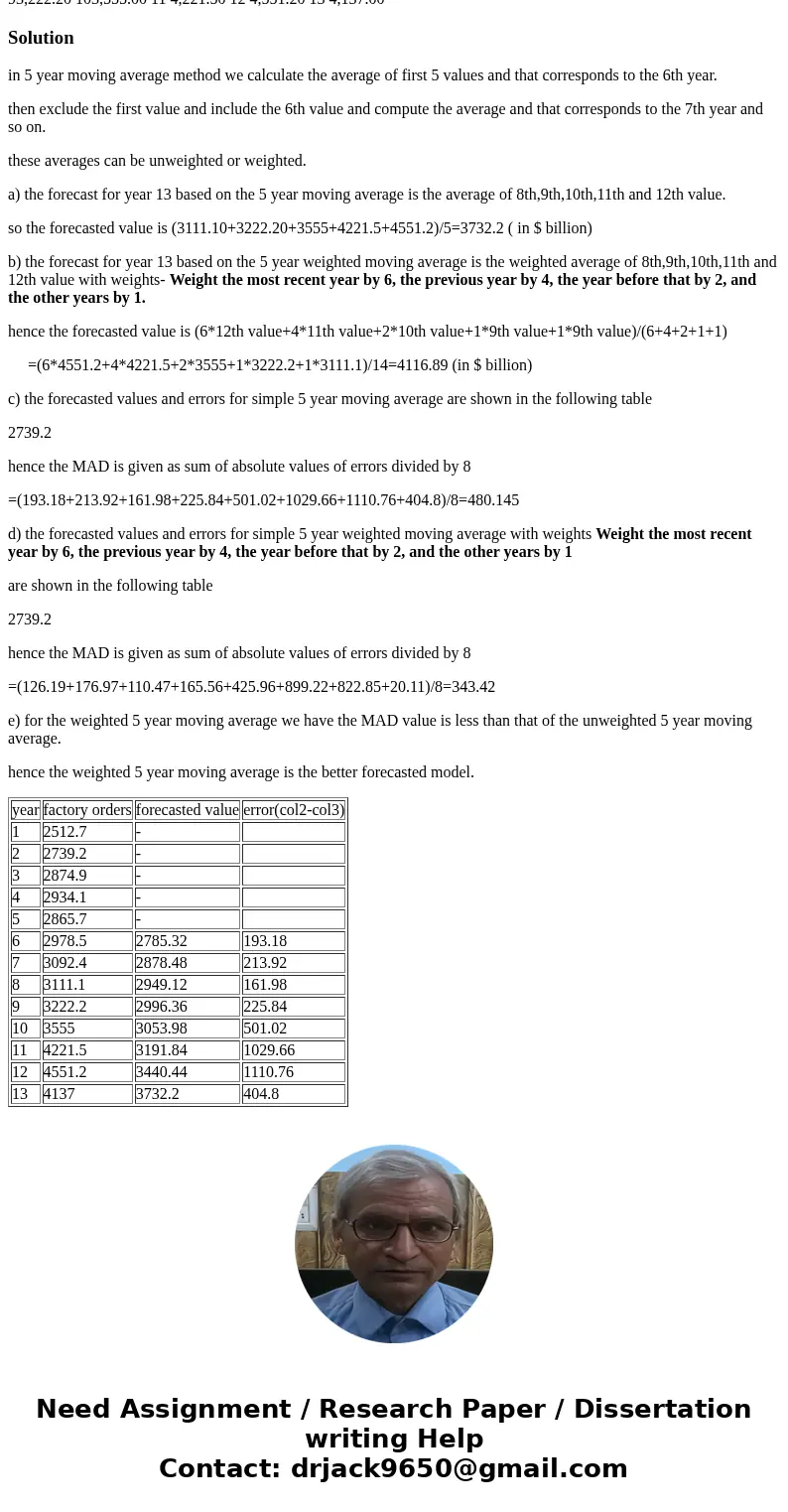The US Census Bureau publishes data on factory orders for al
The U.S. Census Bureau publishes data on factory orders for all manufacturing, durable goods, and nondurable goods industries. Shown here are factory orders in the United States over a 13-year period ($ billion). First, use these data to develop forecasts for the years 6 through 13 using a 5-year moving average. Then, use these data to develop forecasts for the years 6 through 13 using a 5-year weighted moving average. Weight the most recent year by 6, the previous year by 4, the year before that by 2, and the other years by 1.
Answer the following questions:
a) What is the forecast for year 13 based on the 5-year moving average?
b) What is the forecast for year 13 based on the 5-year weighted moving average?
c) What is the MAD for the moving average forecast?
d) What is the MAD for the weighted moving average forecast?
e) Which forecasting model is better?
Show the two forecast & errors
Year Factory Orders $ billion) 12,512.70 2 2,739.20 3 2,874.90 4 2,934.10 52,865.70 6 2,978.50 7 3,092.40 8 3,111.10 93,222.20 103,555.00 11 4,221.50 12 4,551.20 13 4,137.00Solution
in 5 year moving average method we calculate the average of first 5 values and that corresponds to the 6th year.
then exclude the first value and include the 6th value and compute the average and that corresponds to the 7th year and so on.
these averages can be unweighted or weighted.
a) the forecast for year 13 based on the 5 year moving average is the average of 8th,9th,10th,11th and 12th value.
so the forecasted value is (3111.10+3222.20+3555+4221.5+4551.2)/5=3732.2 ( in $ billion)
b) the forecast for year 13 based on the 5 year weighted moving average is the weighted average of 8th,9th,10th,11th and 12th value with weights- Weight the most recent year by 6, the previous year by 4, the year before that by 2, and the other years by 1.
hence the forecasted value is (6*12th value+4*11th value+2*10th value+1*9th value+1*9th value)/(6+4+2+1+1)
=(6*4551.2+4*4221.5+2*3555+1*3222.2+1*3111.1)/14=4116.89 (in $ billion)
c) the forecasted values and errors for simple 5 year moving average are shown in the following table
2739.2
hence the MAD is given as sum of absolute values of errors divided by 8
=(193.18+213.92+161.98+225.84+501.02+1029.66+1110.76+404.8)/8=480.145
d) the forecasted values and errors for simple 5 year weighted moving average with weights Weight the most recent year by 6, the previous year by 4, the year before that by 2, and the other years by 1
are shown in the following table
2739.2
hence the MAD is given as sum of absolute values of errors divided by 8
=(126.19+176.97+110.47+165.56+425.96+899.22+822.85+20.11)/8=343.42
e) for the weighted 5 year moving average we have the MAD value is less than that of the unweighted 5 year moving average.
hence the weighted 5 year moving average is the better forecasted model.
| year | factory orders | forecasted value | error(col2-col3) |
| 1 | 2512.7 | - | |
| 2 | 2739.2 | - | |
| 3 | 2874.9 | - | |
| 4 | 2934.1 | - | |
| 5 | 2865.7 | - | |
| 6 | 2978.5 | 2785.32 | 193.18 |
| 7 | 3092.4 | 2878.48 | 213.92 |
| 8 | 3111.1 | 2949.12 | 161.98 |
| 9 | 3222.2 | 2996.36 | 225.84 |
| 10 | 3555 | 3053.98 | 501.02 |
| 11 | 4221.5 | 3191.84 | 1029.66 |
| 12 | 4551.2 | 3440.44 | 1110.76 |
| 13 | 4137 | 3732.2 | 404.8 |


 Homework Sourse
Homework Sourse